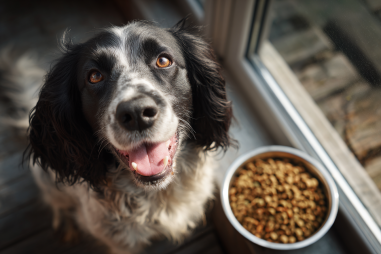Feeding your English Springer Spaniel on a consistent and well-structured schedule is essential for maintaining its health, energy, and happiness. Much like humans, dogs thrive with routine, and regular meal times can improve digestion, prevent overeating, and help you monitor your pet’s overall condition. Whether you have a lively puppy bursting with energy, a calm adult dog, or a wise senior, each stage of life requires a unique approach to feeding. Let’s explore how to create the perfect feeding schedule tailored to your English Springer Spaniel’s needs.
Importance of Regular Feeding Times
Establishing a consistent feeding routine is foundational to your dog’s well-being. Dogs respond well to predictability, and feeding at regular intervals helps regulate their metabolism and digestive system. When your English Springer Spaniel knows when to expect its next meal, it reduces anxiety around food and prevents habits like begging or scavenging.
Regular feeding times also make it easier to monitor your dog’s appetite and notice any changes, which can be an early indicator of health issues. A consistent schedule aids digestion by allowing food to move systematically through the gastrointestinal tract, reducing the risk of upset stomach and obesity.
Recommended Feeding Frequency by Age
Different life stages come with distinct nutritional demands, so feeding frequency and portion sizes vary as your English Springer Spaniel grows.
Puppies
For puppies, frequent small meals are critical to support rapid growth and high energy levels. Typically, puppies from 8 weeks to about 6 months old should be fed:
- Three to four meals a day
This provides steady nourishment and prevents hypoglycemia, as puppies have smaller stomachs and burn energy quickly.
Adult Dogs
Once your English Springer Spaniel reaches adulthood (around 6 months to 7 years), you can switch to:
- Two meals per day – one in the morning and one in the evening
Dividing food intake this way helps maintain energy throughout the day and stabilizes blood sugar levels.
Seniors
Senior dogs, typically over 7 years old, may still thrive on two meals daily, but some might benefit from smaller, more frequent meals if they have digestive sensitivities or dental issues. Consulting with your veterinarian can help tailor the feeding frequency to your senior dog’s specific needs.
Portion Control Guidelines
Feeding the right amount is just as important as feeding on schedule. Overfeeding can lead to obesity, joint issues, and decreased lifespan, while underfeeding may cause nutritional deficiencies and weakness.
The portion size for your English Springer Spaniel depends on factors such as age, weight, activity level, and the type of food given. Most dog food packaging provides general feeding guidelines based on weight, which is a helpful starting point.
As a rule of thumb, an adult English Springer Spaniel weighing between 40 and 50 pounds typically requires between 1.5 to 2.5 cups of high-quality dry food per day, split into two meals. Puppies will need more calorie-dense meals per pound of body weight.
Regularly measuring food with a standard cup ensures consistency, and using a digital scale can be even more accurate. Avoid free-feeding (leaving food out all day) since it makes portion control difficult and promotes overeating.
Balancing Meals and Treats
Treats play a valuable role in training and rewarding good behavior, but they need to be balanced within the overall diet. Excessive treats can upset your dog’s calorie intake, leading to weight gain and nutrition imbalances.
When incorporating treats, aim to keep them to no more than 10% of your dog’s daily caloric intake. Opt for healthy treats like small pieces of cooked chicken, carrots, or commercial treats that are low in fat and calories.
Avoid offering human food scraps or high-fat table scraps, which can cause digestive upset or toxic reactions in English Springer Spaniels.
Signs of Overfeeding or Hunger
It’s important to recognize signals that your English Springer Spaniel may be eating too much or too little.
Signs of Overfeeding:
- Excess weight gain or a noticeable “pot-belly”
- Sluggishness or reluctance to exercise
- Frequent or loose stools
- Increased fat deposits especially around the chest and abdomen
Signs of Hunger or Underfeeding:
- Begging or scavenging for food more often than usual
- Visible ribs or hip bones
- Low energy or lethargy
- Weight loss or muscle wasting
If you notice any of these signs, it’s time to adjust portion sizes or consult your veterinarian for a thorough evaluation.
Adjusting Schedule for Activity Level
An English Springer Spaniel’s energy needs can fluctuate depending on its activity level. These dogs are known for their lively and sporty nature, so active dogs require more calories and possibly slightly larger or more frequent meals compared to couch potatoes.
For dogs that participate in daily vigorous exercise, agility training, or long outdoor adventures, feeding slightly higher amounts balanced with nutrient-rich food supports muscle maintenance and energy levels.
Conversely, if your dog’s lifestyle becomes more sedentary due to injury or aging, lowering the calorie intake and reassessing meal sizes help prevent unwanted weight gain.
Timing meals around exercise is also crucial. Avoid feeding large meals immediately before intense activity to reduce the risk of bloat, a dangerous condition. Typically, allow at least one to two hours after eating before vigorous exercise.
Monitoring Weight and Health
Regularly monitoring your English Springer Spaniel’s weight and overall health is essential for maintaining the right feeding schedule. Weigh your dog monthly or use a reliable body condition scoring method to assess whether your dog is underweight, ideal, or overweight.
Check for physical signs like a defined waist when viewed from above and ribs that can be felt but not seen prominently. Keep an eye on your dog’s coat condition, energy, and digestion, as these reflect nutritional adequacy.
Routine veterinary check-ups provide an opportunity to discuss your dog’s diet and make adjustments based on health changes, ensuring your Springer continues to thrive.
Feeding your English Springer Spaniel isn’t just about giving food—it’s about creating a routine that supports its health, supports its energy level, and enhances the joyful companionship you share. By sticking to consistent meal times, managing portions thoughtfully, balancing treats, and adjusting for activity and age, you set the foundation for a long, vibrant life with your furry friend.







